CHCDEV001: Assessment Book on Confirming Client Developmental Status
VerifiedAdded on 2020/07/22
|31
|11859
|107
Homework Assignment
AI Summary
This assessment book, CHCDEV001, focuses on confirming a client's developmental status, crucial for case managers to assist clients in achieving their goals. The assessment covers key concepts in human development, including Erikson's psychosocial stages and Piaget's cognitive development stages (sensorimotor, pre-operational, concrete operational, and formal operational). The assignment includes true/false questions, table completion to identify psychosocial stages, and case studies to apply these theories. A case study analyzes a 31-year-old male client struggling with forming bonds, evaluating his stage based on Erikson's theory. Another case study explores a 12-month-old child's reaction to a toy covered by a blanket, examining the child's cognitive development. Overall, the assessment evaluates the student's understanding of developmental theories and their application in case management scenarios, with resubmission options for incorrect answers.
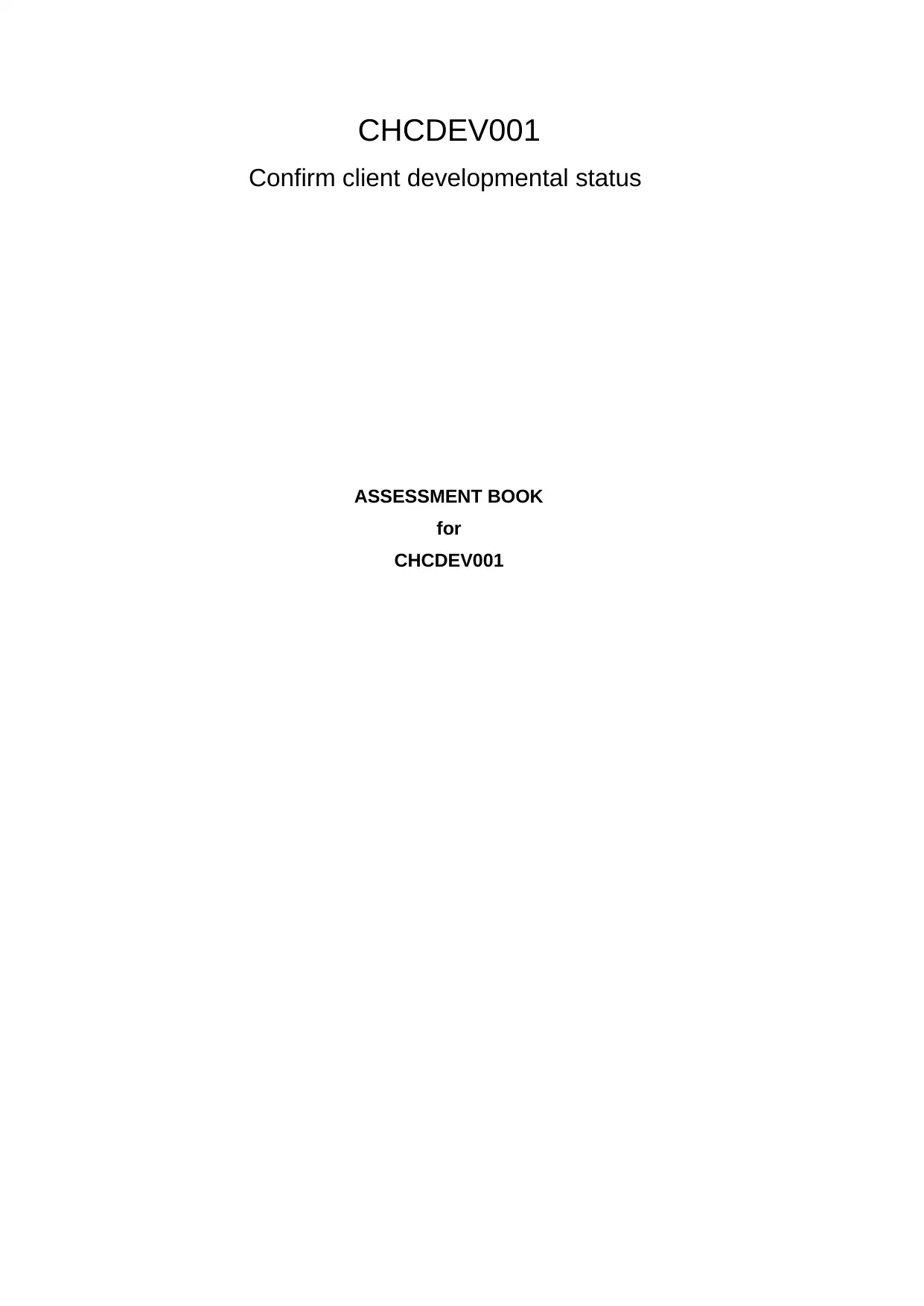
CHCDEV001
Confirm client developmental status
ASSESSMENT BOOK
for
CHCDEV001
Confirm client developmental status
ASSESSMENT BOOK
for
CHCDEV001
Paraphrase This Document
Need a fresh take? Get an instant paraphrase of this document with our AI Paraphraser
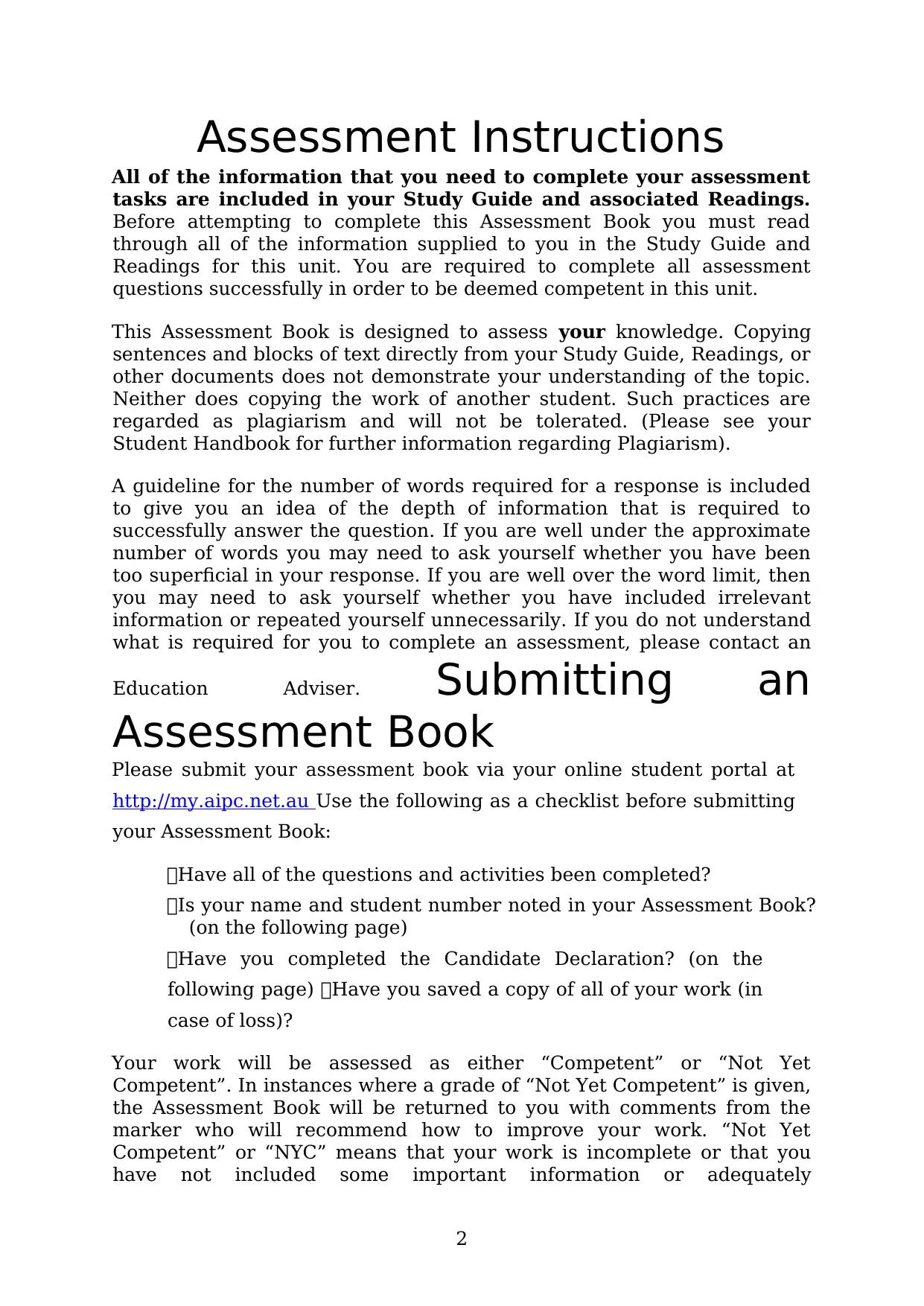
Assessment Instructions
All of the information that you need to complete your assessment
tasks are included in your Study Guide and associated Readings.
Before attempting to complete this Assessment Book you must read
through all of the information supplied to you in the Study Guide and
Readings for this unit. You are required to complete all assessment
questions successfully in order to be deemed competent in this unit.
This Assessment Book is designed to assess your knowledge. Copying
sentences and blocks of text directly from your Study Guide, Readings, or
other documents does not demonstrate your understanding of the topic.
Neither does copying the work of another student. Such practices are
regarded as plagiarism and will not be tolerated. (Please see your
Student Handbook for further information regarding Plagiarism).
A guideline for the number of words required for a response is included
to give you an idea of the depth of information that is required to
successfully answer the question. If you are well under the approximate
number of words you may need to ask yourself whether you have been
too superficial in your response. If you are well over the word limit, then
you may need to ask yourself whether you have included irrelevant
information or repeated yourself unnecessarily. If you do not understand
what is required for you to complete an assessment, please contact an
Education Adviser. Submitting an
Assessment Book
Please submit your assessment book via your online student portal at
http://my.aipc.net.au Use the following as a checklist before submitting
your Assessment Book:
Have all of the questions and activities been completed?
Is your name and student number noted in your Assessment Book?
(on the following page)
Have you completed the Candidate Declaration? (on the
following page) Have you saved a copy of all of your work (in
case of loss)?
Your work will be assessed as either “Competent” or “Not Yet
Competent”. In instances where a grade of “Not Yet Competent” is given,
the Assessment Book will be returned to you with comments from the
marker who will recommend how to improve your work. “Not Yet
Competent” or “NYC” means that your work is incomplete or that you
have not included some important information or adequately
2
All of the information that you need to complete your assessment
tasks are included in your Study Guide and associated Readings.
Before attempting to complete this Assessment Book you must read
through all of the information supplied to you in the Study Guide and
Readings for this unit. You are required to complete all assessment
questions successfully in order to be deemed competent in this unit.
This Assessment Book is designed to assess your knowledge. Copying
sentences and blocks of text directly from your Study Guide, Readings, or
other documents does not demonstrate your understanding of the topic.
Neither does copying the work of another student. Such practices are
regarded as plagiarism and will not be tolerated. (Please see your
Student Handbook for further information regarding Plagiarism).
A guideline for the number of words required for a response is included
to give you an idea of the depth of information that is required to
successfully answer the question. If you are well under the approximate
number of words you may need to ask yourself whether you have been
too superficial in your response. If you are well over the word limit, then
you may need to ask yourself whether you have included irrelevant
information or repeated yourself unnecessarily. If you do not understand
what is required for you to complete an assessment, please contact an
Education Adviser. Submitting an
Assessment Book
Please submit your assessment book via your online student portal at
http://my.aipc.net.au Use the following as a checklist before submitting
your Assessment Book:
Have all of the questions and activities been completed?
Is your name and student number noted in your Assessment Book?
(on the following page)
Have you completed the Candidate Declaration? (on the
following page) Have you saved a copy of all of your work (in
case of loss)?
Your work will be assessed as either “Competent” or “Not Yet
Competent”. In instances where a grade of “Not Yet Competent” is given,
the Assessment Book will be returned to you with comments from the
marker who will recommend how to improve your work. “Not Yet
Competent” or “NYC” means that your work is incomplete or that you
have not included some important information or adequately
2
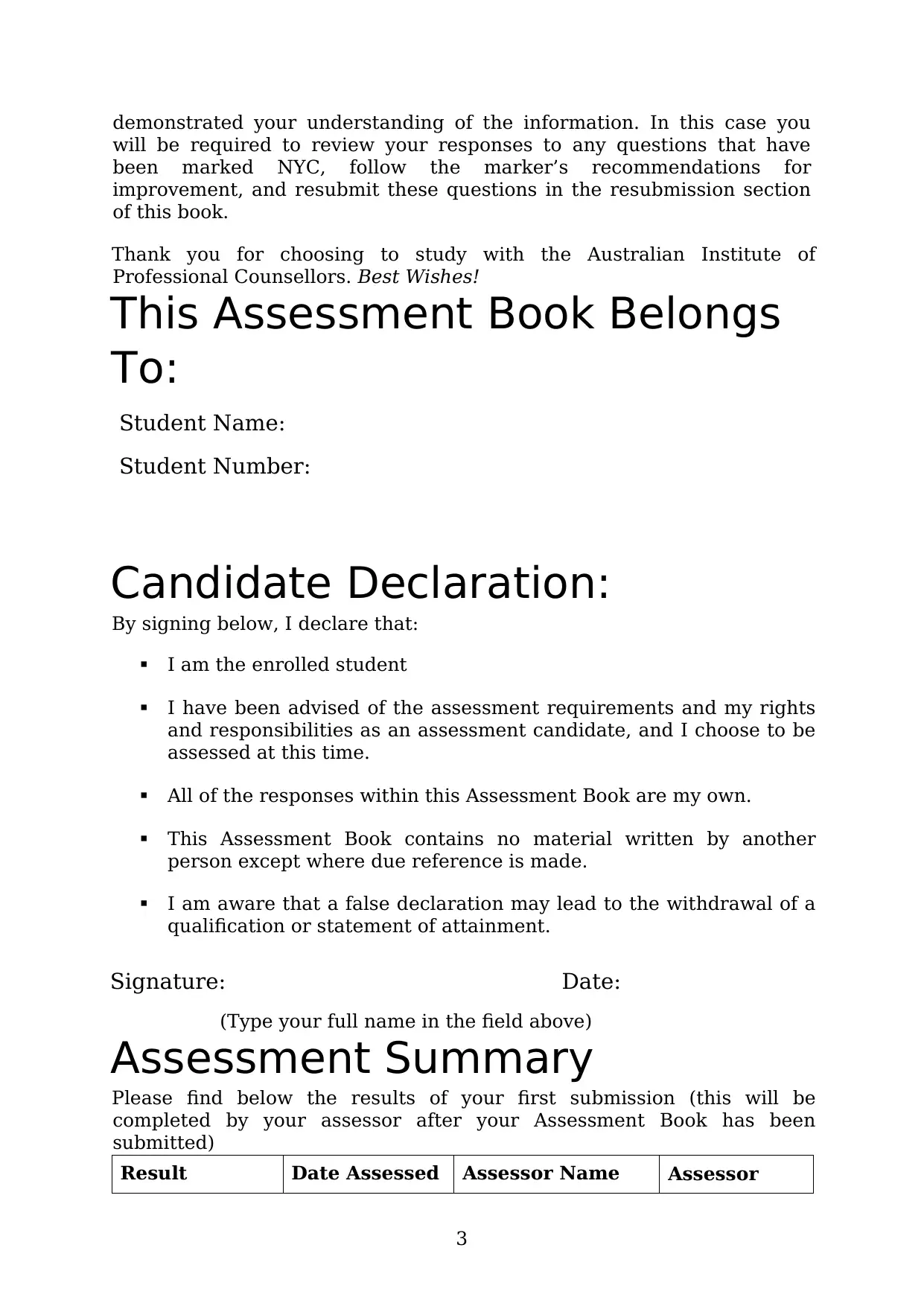
demonstrated your understanding of the information. In this case you
will be required to review your responses to any questions that have
been marked NYC, follow the marker’s recommendations for
improvement, and resubmit these questions in the resubmission section
of this book.
Thank you for choosing to study with the Australian Institute of
Professional Counsellors. Best Wishes!
This Assessment Book Belongs
To:
Student Name:
Student Number:
Candidate Declaration:
By signing below, I declare that:
I am the enrolled student
I have been advised of the assessment requirements and my rights
and responsibilities as an assessment candidate, and I choose to be
assessed at this time.
All of the responses within this Assessment Book are my own.
This Assessment Book contains no material written by another
person except where due reference is made.
I am aware that a false declaration may lead to the withdrawal of a
qualification or statement of attainment.
Signature: Date:
(Type your full name in the field above)
Assessment Summary
Please find below the results of your first submission (this will be
completed by your assessor after your Assessment Book has been
submitted)
Result Date Assessed Assessor Name Assessor
3
will be required to review your responses to any questions that have
been marked NYC, follow the marker’s recommendations for
improvement, and resubmit these questions in the resubmission section
of this book.
Thank you for choosing to study with the Australian Institute of
Professional Counsellors. Best Wishes!
This Assessment Book Belongs
To:
Student Name:
Student Number:
Candidate Declaration:
By signing below, I declare that:
I am the enrolled student
I have been advised of the assessment requirements and my rights
and responsibilities as an assessment candidate, and I choose to be
assessed at this time.
All of the responses within this Assessment Book are my own.
This Assessment Book contains no material written by another
person except where due reference is made.
I am aware that a false declaration may lead to the withdrawal of a
qualification or statement of attainment.
Signature: Date:
(Type your full name in the field above)
Assessment Summary
Please find below the results of your first submission (this will be
completed by your assessor after your Assessment Book has been
submitted)
Result Date Assessed Assessor Name Assessor
3
⊘ This is a preview!⊘
Do you want full access?
Subscribe today to unlock all pages.

Trusted by 1+ million students worldwide
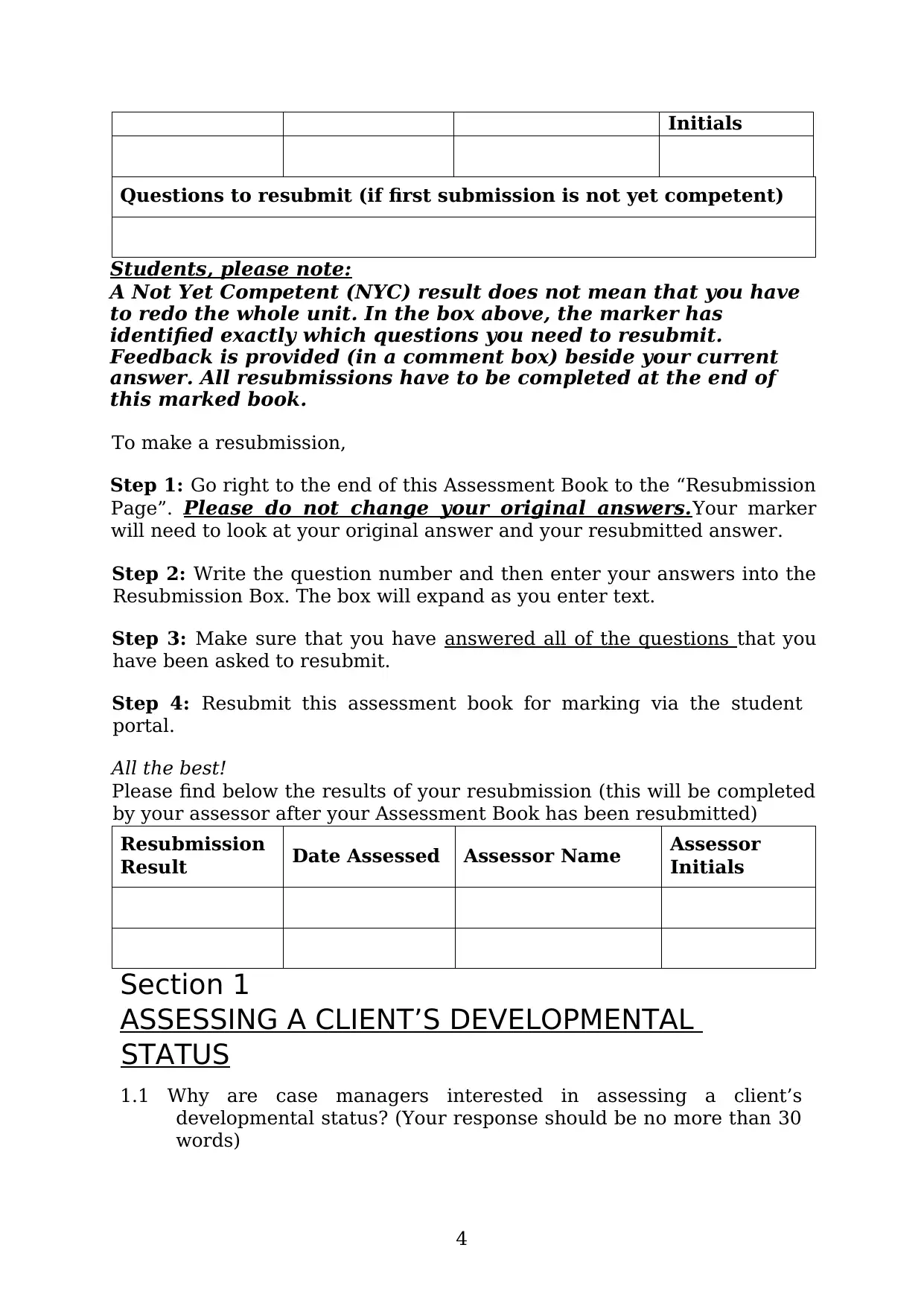
Initials
Questions to resubmit (if first submission is not yet competent)
Students, please note:
A Not Yet Competent (NYC) result does not mean that you have
to redo the whole unit. In the box above, the marker has
identified exactly which questions you need to resubmit.
Feedback is provided (in a comment box) beside your current
answer. All resubmissions have to be completed at the end of
this marked book.
To make a resubmission,
Step 1: Go right to the end of this Assessment Book to the “Resubmission
Page”. Please do not change your original answers.Your marker
will need to look at your original answer and your resubmitted answer.
Step 2: Write the question number and then enter your answers into the
Resubmission Box. The box will expand as you enter text.
Step 3: Make sure that you have answered all of the questions that you
have been asked to resubmit.
Step 4: Resubmit this assessment book for marking via the student
portal.
All the best!
Please find below the results of your resubmission (this will be completed
by your assessor after your Assessment Book has been resubmitted)
Resubmission
Result Date Assessed Assessor Name Assessor
Initials
Section 1
ASSESSING A CLIENT’S DEVELOPMENTAL
STATUS
1.1 Why are case managers interested in assessing a client’s
developmental status? (Your response should be no more than 30
words)
4
Questions to resubmit (if first submission is not yet competent)
Students, please note:
A Not Yet Competent (NYC) result does not mean that you have
to redo the whole unit. In the box above, the marker has
identified exactly which questions you need to resubmit.
Feedback is provided (in a comment box) beside your current
answer. All resubmissions have to be completed at the end of
this marked book.
To make a resubmission,
Step 1: Go right to the end of this Assessment Book to the “Resubmission
Page”. Please do not change your original answers.Your marker
will need to look at your original answer and your resubmitted answer.
Step 2: Write the question number and then enter your answers into the
Resubmission Box. The box will expand as you enter text.
Step 3: Make sure that you have answered all of the questions that you
have been asked to resubmit.
Step 4: Resubmit this assessment book for marking via the student
portal.
All the best!
Please find below the results of your resubmission (this will be completed
by your assessor after your Assessment Book has been resubmitted)
Resubmission
Result Date Assessed Assessor Name Assessor
Initials
Section 1
ASSESSING A CLIENT’S DEVELOPMENTAL
STATUS
1.1 Why are case managers interested in assessing a client’s
developmental status? (Your response should be no more than 30
words)
4
Paraphrase This Document
Need a fresh take? Get an instant paraphrase of this document with our AI Paraphraser
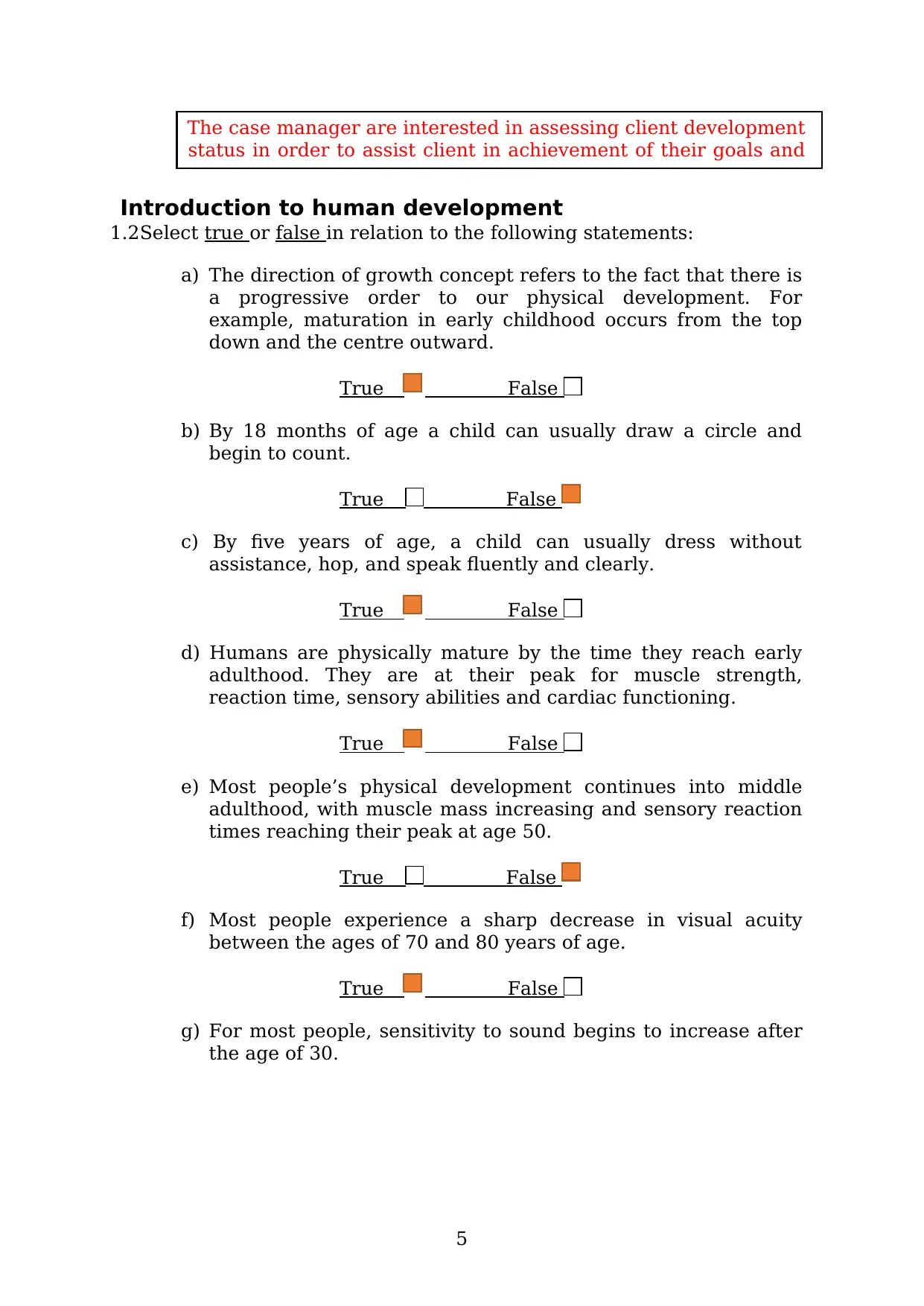
Introduction to human development
1.2Select true or false in relation to the following statements:
a) The direction of growth concept refers to the fact that there is
a progressive order to our physical development. For
example, maturation in early childhood occurs from the top
down and the centre outward.
True False
b) By 18 months of age a child can usually draw a circle and
begin to count.
True False
c) By five years of age, a child can usually dress without
assistance, hop, and speak fluently and clearly.
True False
d) Humans are physically mature by the time they reach early
adulthood. They are at their peak for muscle strength,
reaction time, sensory abilities and cardiac functioning.
True False
e) Most people’s physical development continues into middle
adulthood, with muscle mass increasing and sensory reaction
times reaching their peak at age 50.
True False
f) Most people experience a sharp decrease in visual acuity
between the ages of 70 and 80 years of age.
True False
g) For most people, sensitivity to sound begins to increase after
the age of 30.
5
The case manager are interested in assessing client development
status in order to assist client in achievement of their goals and
objectives.
1.2Select true or false in relation to the following statements:
a) The direction of growth concept refers to the fact that there is
a progressive order to our physical development. For
example, maturation in early childhood occurs from the top
down and the centre outward.
True False
b) By 18 months of age a child can usually draw a circle and
begin to count.
True False
c) By five years of age, a child can usually dress without
assistance, hop, and speak fluently and clearly.
True False
d) Humans are physically mature by the time they reach early
adulthood. They are at their peak for muscle strength,
reaction time, sensory abilities and cardiac functioning.
True False
e) Most people’s physical development continues into middle
adulthood, with muscle mass increasing and sensory reaction
times reaching their peak at age 50.
True False
f) Most people experience a sharp decrease in visual acuity
between the ages of 70 and 80 years of age.
True False
g) For most people, sensitivity to sound begins to increase after
the age of 30.
5
The case manager are interested in assessing client development
status in order to assist client in achievement of their goals and
objectives.
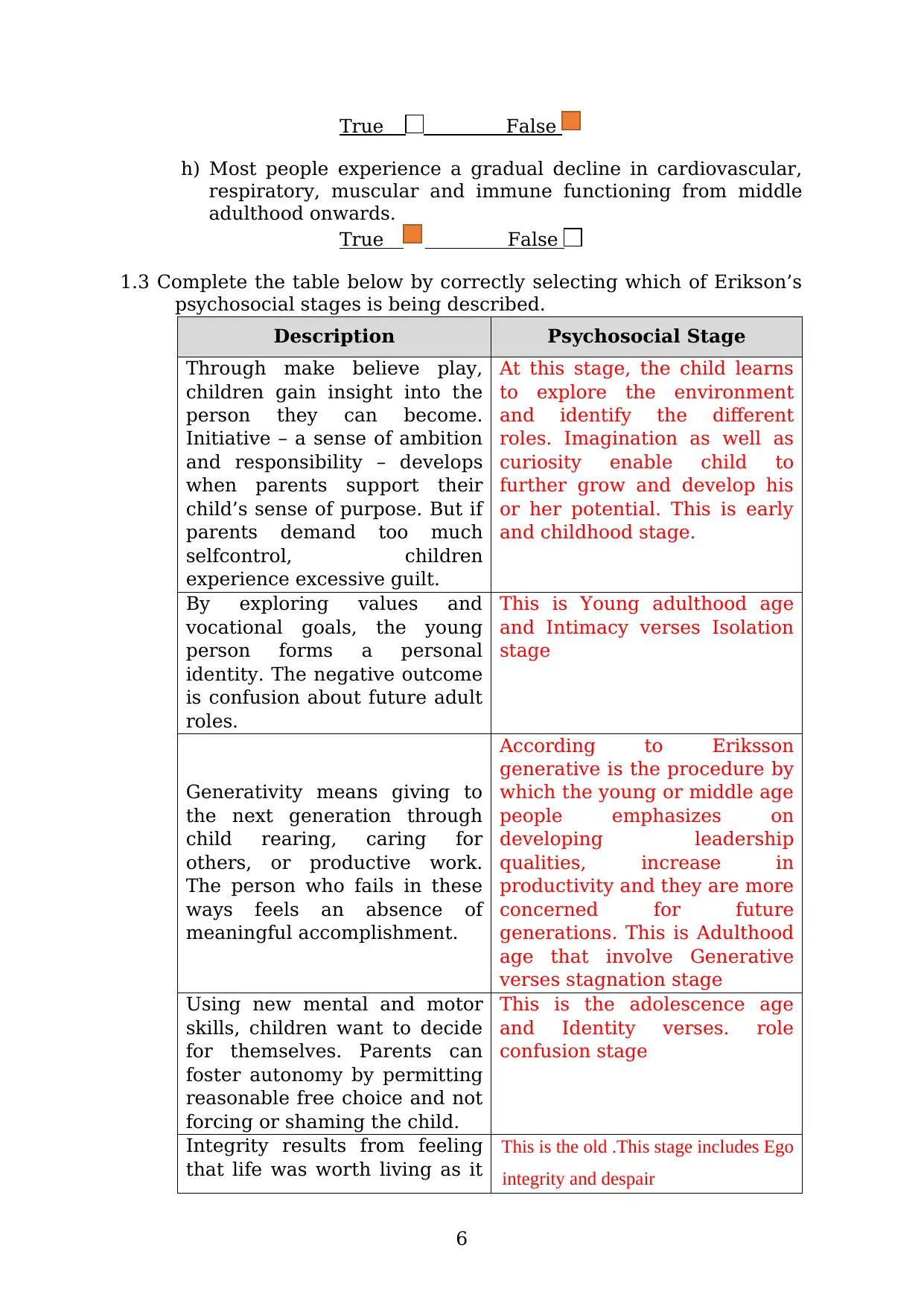
True False
h) Most people experience a gradual decline in cardiovascular,
respiratory, muscular and immune functioning from middle
adulthood onwards.
True False
1.3 Complete the table below by correctly selecting which of Erikson’s
psychosocial stages is being described.
Description Psychosocial Stage
Through make believe play,
children gain insight into the
person they can become.
Initiative – a sense of ambition
and responsibility – develops
when parents support their
child’s sense of purpose. But if
parents demand too much
selfcontrol, children
experience excessive guilt.
At this stage, the child learns
to explore the environment
and identify the different
roles. Imagination as well as
curiosity enable child to
further grow and develop his
or her potential. This is early
and childhood stage.
By exploring values and
vocational goals, the young
person forms a personal
identity. The negative outcome
is confusion about future adult
roles.
This is Young adulthood age
and Intimacy verses Isolation
stage
Generativity means giving to
the next generation through
child rearing, caring for
others, or productive work.
The person who fails in these
ways feels an absence of
meaningful accomplishment.
According to Eriksson
generative is the procedure by
which the young or middle age
people emphasizes on
developing leadership
qualities, increase in
productivity and they are more
concerned for future
generations. This is Adulthood
age that involve Generative
verses stagnation stage
Using new mental and motor
skills, children want to decide
for themselves. Parents can
foster autonomy by permitting
reasonable free choice and not
forcing or shaming the child.
This is the adolescence age
and Identity verses. role
confusion stage
Integrity results from feeling
that life was worth living as it
This is the old .This stage includes Ego
integrity and despair
6
h) Most people experience a gradual decline in cardiovascular,
respiratory, muscular and immune functioning from middle
adulthood onwards.
True False
1.3 Complete the table below by correctly selecting which of Erikson’s
psychosocial stages is being described.
Description Psychosocial Stage
Through make believe play,
children gain insight into the
person they can become.
Initiative – a sense of ambition
and responsibility – develops
when parents support their
child’s sense of purpose. But if
parents demand too much
selfcontrol, children
experience excessive guilt.
At this stage, the child learns
to explore the environment
and identify the different
roles. Imagination as well as
curiosity enable child to
further grow and develop his
or her potential. This is early
and childhood stage.
By exploring values and
vocational goals, the young
person forms a personal
identity. The negative outcome
is confusion about future adult
roles.
This is Young adulthood age
and Intimacy verses Isolation
stage
Generativity means giving to
the next generation through
child rearing, caring for
others, or productive work.
The person who fails in these
ways feels an absence of
meaningful accomplishment.
According to Eriksson
generative is the procedure by
which the young or middle age
people emphasizes on
developing leadership
qualities, increase in
productivity and they are more
concerned for future
generations. This is Adulthood
age that involve Generative
verses stagnation stage
Using new mental and motor
skills, children want to decide
for themselves. Parents can
foster autonomy by permitting
reasonable free choice and not
forcing or shaming the child.
This is the adolescence age
and Identity verses. role
confusion stage
Integrity results from feeling
that life was worth living as it
This is the old .This stage includes Ego
integrity and despair
6
⊘ This is a preview!⊘
Do you want full access?
Subscribe today to unlock all pages.

Trusted by 1+ million students worldwide
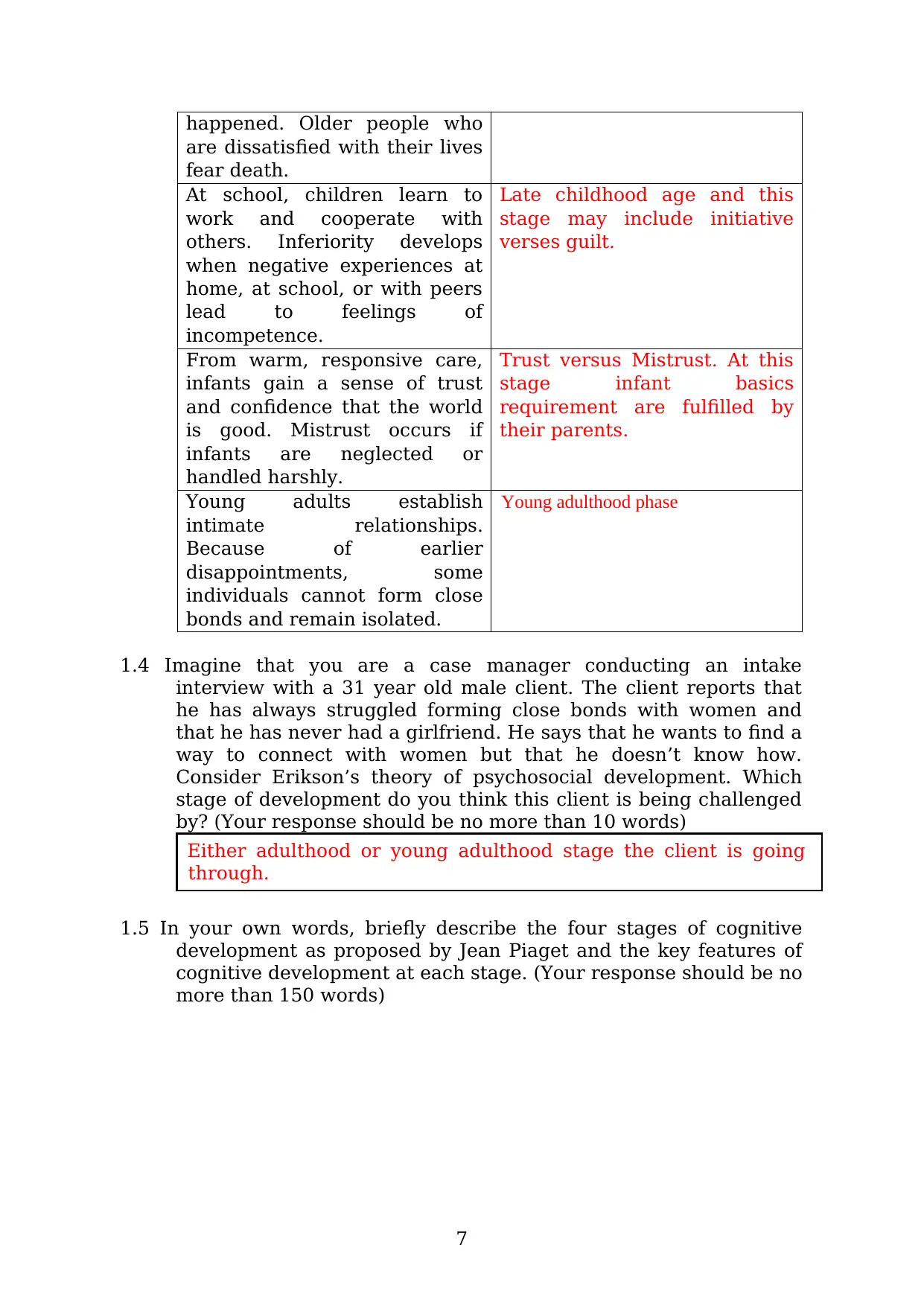
happened. Older people who
are dissatisfied with their lives
fear death.
At school, children learn to
work and cooperate with
others. Inferiority develops
when negative experiences at
home, at school, or with peers
lead to feelings of
incompetence.
Late childhood age and this
stage may include initiative
verses guilt.
From warm, responsive care,
infants gain a sense of trust
and confidence that the world
is good. Mistrust occurs if
infants are neglected or
handled harshly.
Trust versus Mistrust. At this
stage infant basics
requirement are fulfilled by
their parents.
Young adults establish
intimate relationships.
Because of earlier
disappointments, some
individuals cannot form close
bonds and remain isolated.
Young adulthood phase
1.4 Imagine that you are a case manager conducting an intake
interview with a 31 year old male client. The client reports that
he has always struggled forming close bonds with women and
that he has never had a girlfriend. He says that he wants to find a
way to connect with women but that he doesn’t know how.
Consider Erikson’s theory of psychosocial development. Which
stage of development do you think this client is being challenged
by? (Your response should be no more than 10 words)
1.5 In your own words, briefly describe the four stages of cognitive
development as proposed by Jean Piaget and the key features of
cognitive development at each stage. (Your response should be no
more than 150 words)
7
Either adulthood or young adulthood stage the client is going
through.
are dissatisfied with their lives
fear death.
At school, children learn to
work and cooperate with
others. Inferiority develops
when negative experiences at
home, at school, or with peers
lead to feelings of
incompetence.
Late childhood age and this
stage may include initiative
verses guilt.
From warm, responsive care,
infants gain a sense of trust
and confidence that the world
is good. Mistrust occurs if
infants are neglected or
handled harshly.
Trust versus Mistrust. At this
stage infant basics
requirement are fulfilled by
their parents.
Young adults establish
intimate relationships.
Because of earlier
disappointments, some
individuals cannot form close
bonds and remain isolated.
Young adulthood phase
1.4 Imagine that you are a case manager conducting an intake
interview with a 31 year old male client. The client reports that
he has always struggled forming close bonds with women and
that he has never had a girlfriend. He says that he wants to find a
way to connect with women but that he doesn’t know how.
Consider Erikson’s theory of psychosocial development. Which
stage of development do you think this client is being challenged
by? (Your response should be no more than 10 words)
1.5 In your own words, briefly describe the four stages of cognitive
development as proposed by Jean Piaget and the key features of
cognitive development at each stage. (Your response should be no
more than 150 words)
7
Either adulthood or young adulthood stage the client is going
through.
Paraphrase This Document
Need a fresh take? Get an instant paraphrase of this document with our AI Paraphraser
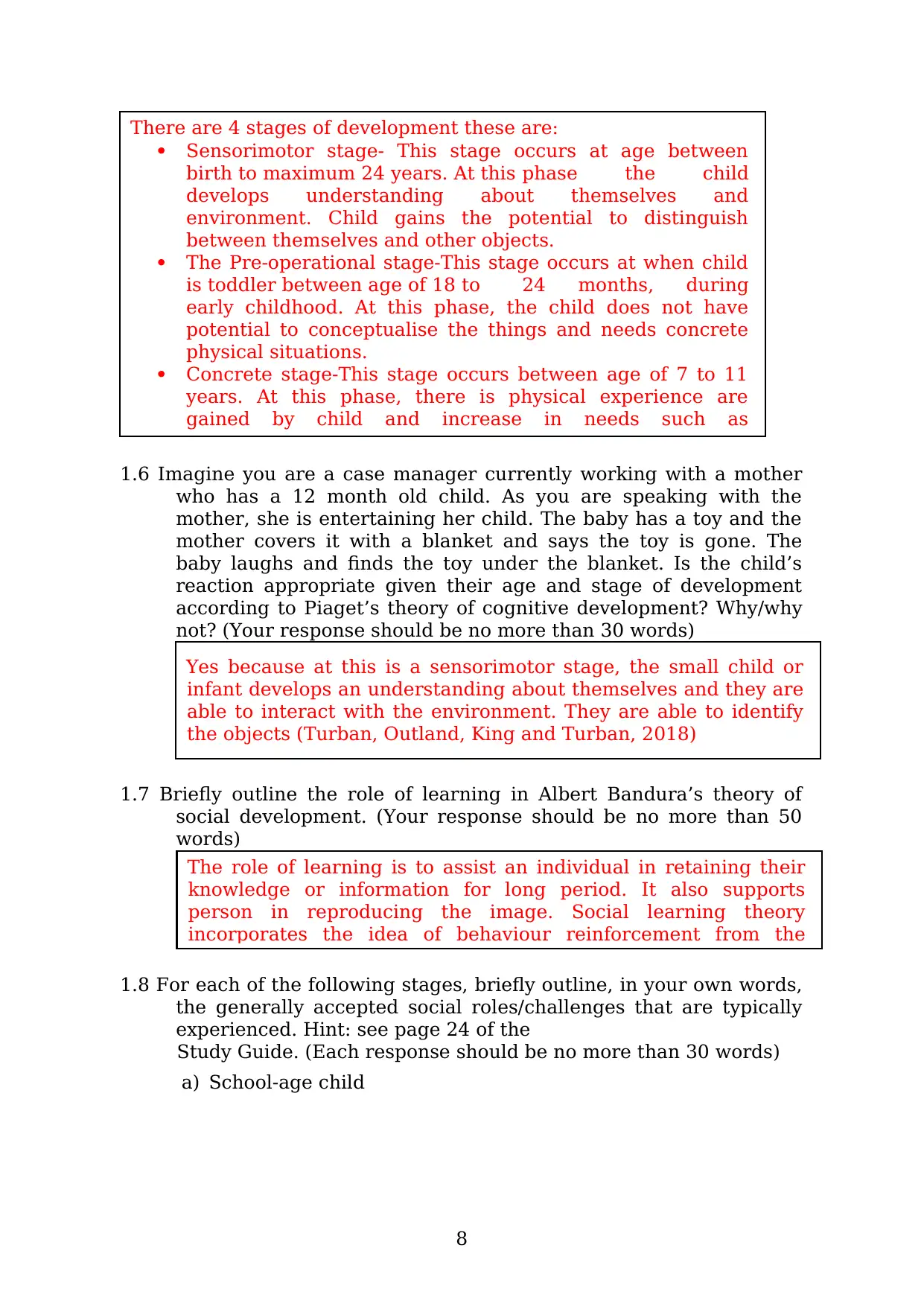
1.6 Imagine you are a case manager currently working with a mother
who has a 12 month old child. As you are speaking with the
mother, she is entertaining her child. The baby has a toy and the
mother covers it with a blanket and says the toy is gone. The
baby laughs and finds the toy under the blanket. Is the child’s
reaction appropriate given their age and stage of development
according to Piaget’s theory of cognitive development? Why/why
not? (Your response should be no more than 30 words)
1.7 Briefly outline the role of learning in Albert Bandura’s theory of
social development. (Your response should be no more than 50
words)
1.8 For each of the following stages, briefly outline, in your own words,
the generally accepted social roles/challenges that are typically
experienced. Hint: see page 24 of the
Study Guide. (Each response should be no more than 30 words)
a) School-age child
8
There are 4 stages of development these are:
Sensorimotor stage- This stage occurs at age between
birth to maximum 24 years. At this phase the child
develops understanding about themselves and
environment. Child gains the potential to distinguish
between themselves and other objects.
The Pre-operational stage-This stage occurs at when child
is toddler between age of 18 to 24 months, during
early childhood. At this phase, the child does not have
potential to conceptualise the things and needs concrete
physical situations.
Concrete stage-This stage occurs between age of 7 to 11
years. At this phase, there is physical experience are
gained by child and increase in needs such as
accommodation.
Yes because at this is a sensorimotor stage, the small child or
infant develops an understanding about themselves and they are
able to interact with the environment. They are able to identify
the objects (Turban, Outland, King and Turban, 2018)
The role of learning is to assist an individual in retaining their
knowledge or information for long period. It also supports
person in reproducing the image. Social learning theory
incorporates the idea of behaviour reinforcement from the
who has a 12 month old child. As you are speaking with the
mother, she is entertaining her child. The baby has a toy and the
mother covers it with a blanket and says the toy is gone. The
baby laughs and finds the toy under the blanket. Is the child’s
reaction appropriate given their age and stage of development
according to Piaget’s theory of cognitive development? Why/why
not? (Your response should be no more than 30 words)
1.7 Briefly outline the role of learning in Albert Bandura’s theory of
social development. (Your response should be no more than 50
words)
1.8 For each of the following stages, briefly outline, in your own words,
the generally accepted social roles/challenges that are typically
experienced. Hint: see page 24 of the
Study Guide. (Each response should be no more than 30 words)
a) School-age child
8
There are 4 stages of development these are:
Sensorimotor stage- This stage occurs at age between
birth to maximum 24 years. At this phase the child
develops understanding about themselves and
environment. Child gains the potential to distinguish
between themselves and other objects.
The Pre-operational stage-This stage occurs at when child
is toddler between age of 18 to 24 months, during
early childhood. At this phase, the child does not have
potential to conceptualise the things and needs concrete
physical situations.
Concrete stage-This stage occurs between age of 7 to 11
years. At this phase, there is physical experience are
gained by child and increase in needs such as
accommodation.
Yes because at this is a sensorimotor stage, the small child or
infant develops an understanding about themselves and they are
able to interact with the environment. They are able to identify
the objects (Turban, Outland, King and Turban, 2018)
The role of learning is to assist an individual in retaining their
knowledge or information for long period. It also supports
person in reproducing the image. Social learning theory
incorporates the idea of behaviour reinforcement from the
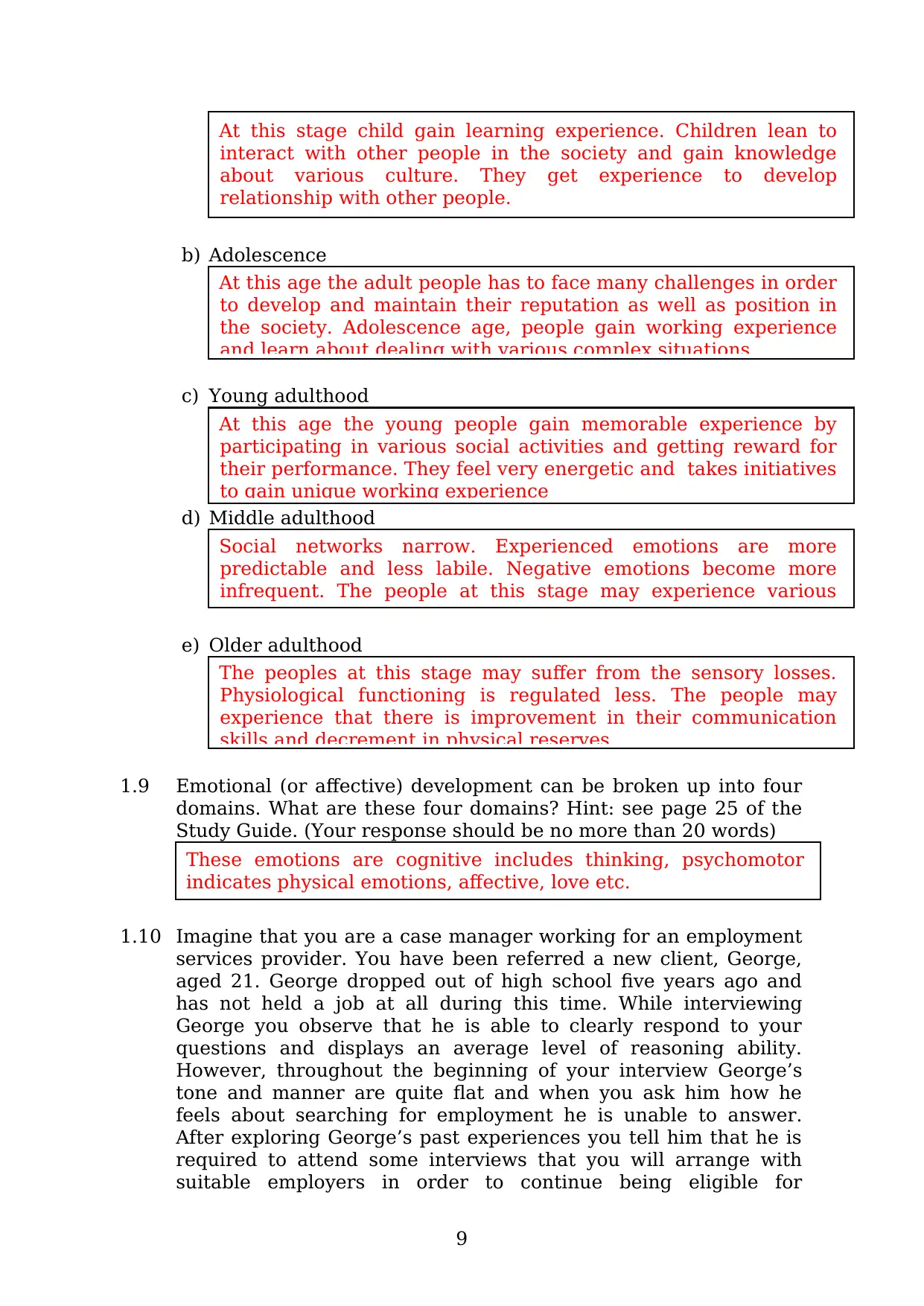
b) Adolescence
c) Young adulthood
d) Middle adulthood
e) Older adulthood
1.9 Emotional (or affective) development can be broken up into four
domains. What are these four domains? Hint: see page 25 of the
Study Guide. (Your response should be no more than 20 words)
1.10 Imagine that you are a case manager working for an employment
services provider. You have been referred a new client, George,
aged 21. George dropped out of high school five years ago and
has not held a job at all during this time. While interviewing
George you observe that he is able to clearly respond to your
questions and displays an average level of reasoning ability.
However, throughout the beginning of your interview George’s
tone and manner are quite flat and when you ask him how he
feels about searching for employment he is unable to answer.
After exploring George’s past experiences you tell him that he is
required to attend some interviews that you will arrange with
suitable employers in order to continue being eligible for
9
At this stage child gain learning experience. Children lean to
interact with other people in the society and gain knowledge
about various culture. They get experience to develop
relationship with other people.
At this age the adult people has to face many challenges in order
to develop and maintain their reputation as well as position in
the society. Adolescence age, people gain working experience
and learn about dealing with various complex situations.
At this age the young people gain memorable experience by
participating in various social activities and getting reward for
their performance. They feel very energetic and takes initiatives
to gain unique working experience
Social networks narrow. Experienced emotions are more
predictable and less labile. Negative emotions become more
infrequent. The people at this stage may experience various
changes in their lifestyle.
The peoples at this stage may suffer from the sensory losses.
Physiological functioning is regulated less. The people may
experience that there is improvement in their communication
skills and decrement in physical reserves.
These emotions are cognitive includes thinking, psychomotor
indicates physical emotions, affective, love etc.
c) Young adulthood
d) Middle adulthood
e) Older adulthood
1.9 Emotional (or affective) development can be broken up into four
domains. What are these four domains? Hint: see page 25 of the
Study Guide. (Your response should be no more than 20 words)
1.10 Imagine that you are a case manager working for an employment
services provider. You have been referred a new client, George,
aged 21. George dropped out of high school five years ago and
has not held a job at all during this time. While interviewing
George you observe that he is able to clearly respond to your
questions and displays an average level of reasoning ability.
However, throughout the beginning of your interview George’s
tone and manner are quite flat and when you ask him how he
feels about searching for employment he is unable to answer.
After exploring George’s past experiences you tell him that he is
required to attend some interviews that you will arrange with
suitable employers in order to continue being eligible for
9
At this stage child gain learning experience. Children lean to
interact with other people in the society and gain knowledge
about various culture. They get experience to develop
relationship with other people.
At this age the adult people has to face many challenges in order
to develop and maintain their reputation as well as position in
the society. Adolescence age, people gain working experience
and learn about dealing with various complex situations.
At this age the young people gain memorable experience by
participating in various social activities and getting reward for
their performance. They feel very energetic and takes initiatives
to gain unique working experience
Social networks narrow. Experienced emotions are more
predictable and less labile. Negative emotions become more
infrequent. The people at this stage may experience various
changes in their lifestyle.
The peoples at this stage may suffer from the sensory losses.
Physiological functioning is regulated less. The people may
experience that there is improvement in their communication
skills and decrement in physical reserves.
These emotions are cognitive includes thinking, psychomotor
indicates physical emotions, affective, love etc.
⊘ This is a preview!⊘
Do you want full access?
Subscribe today to unlock all pages.

Trusted by 1+ million students worldwide
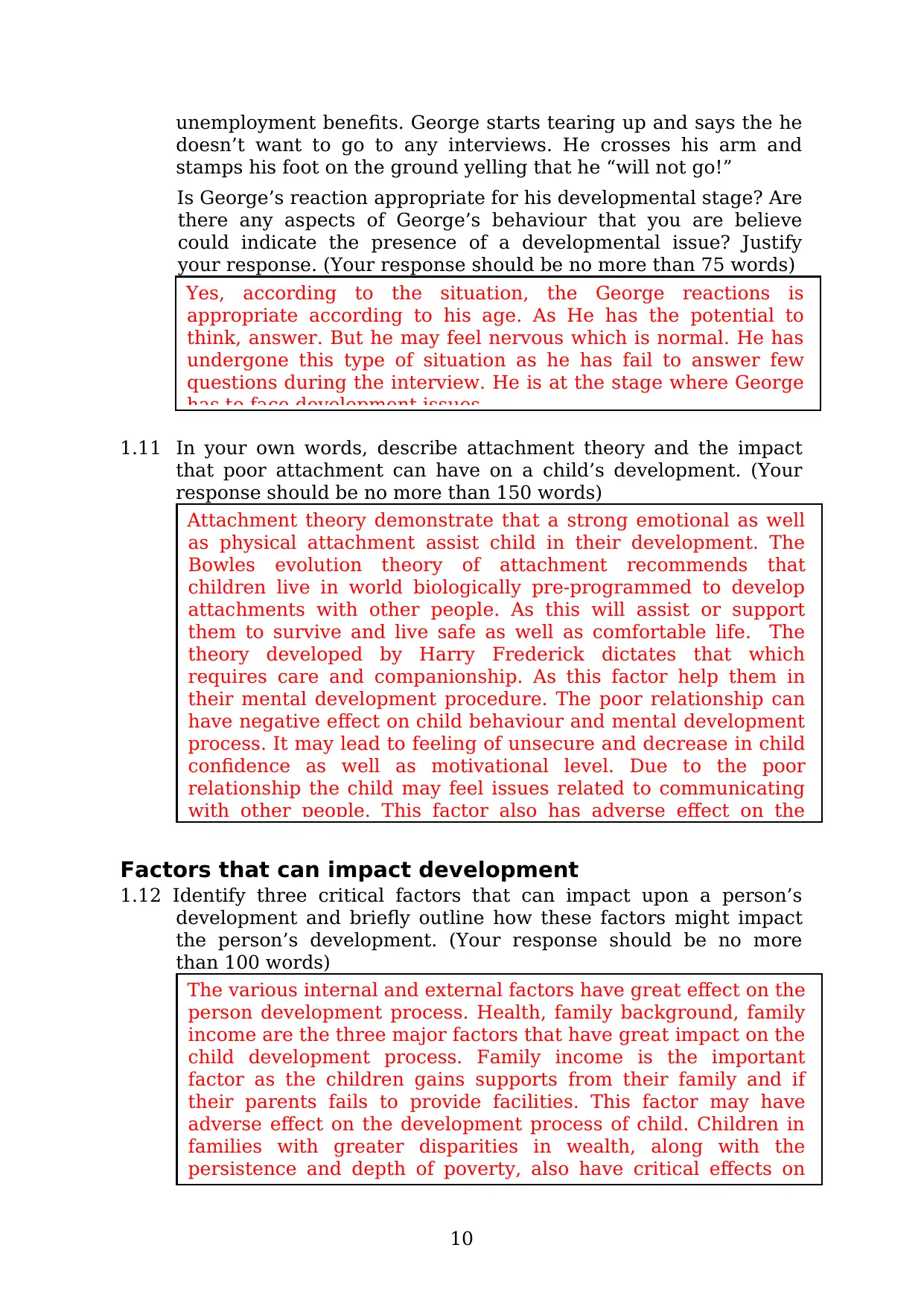
unemployment benefits. George starts tearing up and says the he
doesn’t want to go to any interviews. He crosses his arm and
stamps his foot on the ground yelling that he “will not go!”
Is George’s reaction appropriate for his developmental stage? Are
there any aspects of George’s behaviour that you are believe
could indicate the presence of a developmental issue? Justify
your response. (Your response should be no more than 75 words)
1.11 In your own words, describe attachment theory and the impact
that poor attachment can have on a child’s development. (Your
response should be no more than 150 words)
Factors that can impact development
1.12 Identify three critical factors that can impact upon a person’s
development and briefly outline how these factors might impact
the person’s development. (Your response should be no more
than 100 words)
10
Yes, according to the situation, the George reactions is
appropriate according to his age. As He has the potential to
think, answer. But he may feel nervous which is normal. He has
undergone this type of situation as he has fail to answer few
questions during the interview. He is at the stage where George
has to face development issues
Attachment theory demonstrate that a strong emotional as well
as physical attachment assist child in their development. The
Bowles evolution theory of attachment recommends that
children live in world biologically pre-programmed to develop
attachments with other people. As this will assist or support
them to survive and live safe as well as comfortable life. The
theory developed by Harry Frederick dictates that which
requires care and companionship. As this factor help them in
their mental development procedure. The poor relationship can
have negative effect on child behaviour and mental development
process. It may lead to feeling of unsecure and decrease in child
confidence as well as motivational level. Due to the poor
relationship the child may feel issues related to communicating
with other people. This factor also has adverse effect on the
The various internal and external factors have great effect on the
person development process. Health, family background, family
income are the three major factors that have great impact on the
child development process. Family income is the important
factor as the children gains supports from their family and if
their parents fails to provide facilities. This factor may have
adverse effect on the development process of child. Children in
families with greater disparities in wealth, along with the
persistence and depth of poverty, also have critical effects on
doesn’t want to go to any interviews. He crosses his arm and
stamps his foot on the ground yelling that he “will not go!”
Is George’s reaction appropriate for his developmental stage? Are
there any aspects of George’s behaviour that you are believe
could indicate the presence of a developmental issue? Justify
your response. (Your response should be no more than 75 words)
1.11 In your own words, describe attachment theory and the impact
that poor attachment can have on a child’s development. (Your
response should be no more than 150 words)
Factors that can impact development
1.12 Identify three critical factors that can impact upon a person’s
development and briefly outline how these factors might impact
the person’s development. (Your response should be no more
than 100 words)
10
Yes, according to the situation, the George reactions is
appropriate according to his age. As He has the potential to
think, answer. But he may feel nervous which is normal. He has
undergone this type of situation as he has fail to answer few
questions during the interview. He is at the stage where George
has to face development issues
Attachment theory demonstrate that a strong emotional as well
as physical attachment assist child in their development. The
Bowles evolution theory of attachment recommends that
children live in world biologically pre-programmed to develop
attachments with other people. As this will assist or support
them to survive and live safe as well as comfortable life. The
theory developed by Harry Frederick dictates that which
requires care and companionship. As this factor help them in
their mental development procedure. The poor relationship can
have negative effect on child behaviour and mental development
process. It may lead to feeling of unsecure and decrease in child
confidence as well as motivational level. Due to the poor
relationship the child may feel issues related to communicating
with other people. This factor also has adverse effect on the
The various internal and external factors have great effect on the
person development process. Health, family background, family
income are the three major factors that have great impact on the
child development process. Family income is the important
factor as the children gains supports from their family and if
their parents fails to provide facilities. This factor may have
adverse effect on the development process of child. Children in
families with greater disparities in wealth, along with the
persistence and depth of poverty, also have critical effects on
Paraphrase This Document
Need a fresh take? Get an instant paraphrase of this document with our AI Paraphraser
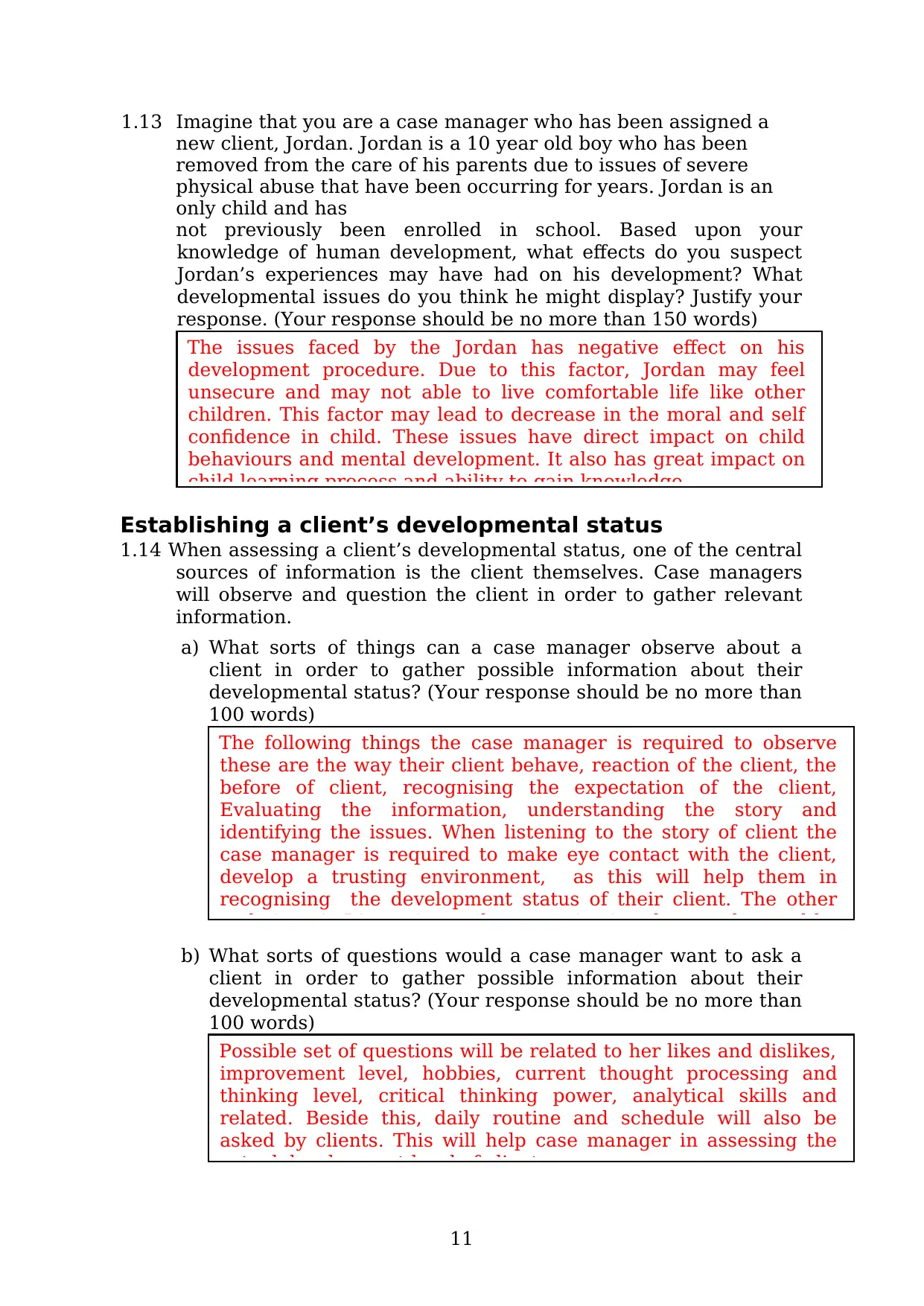
1.13 Imagine that you are a case manager who has been assigned a
new client, Jordan. Jordan is a 10 year old boy who has been
removed from the care of his parents due to issues of severe
physical abuse that have been occurring for years. Jordan is an
only child and has
not previously been enrolled in school. Based upon your
knowledge of human development, what effects do you suspect
Jordan’s experiences may have had on his development? What
developmental issues do you think he might display? Justify your
response. (Your response should be no more than 150 words)
Establishing a client’s developmental status
1.14 When assessing a client’s developmental status, one of the central
sources of information is the client themselves. Case managers
will observe and question the client in order to gather relevant
information.
a) What sorts of things can a case manager observe about a
client in order to gather possible information about their
developmental status? (Your response should be no more than
100 words)
b) What sorts of questions would a case manager want to ask a
client in order to gather possible information about their
developmental status? (Your response should be no more than
100 words)
11
The issues faced by the Jordan has negative effect on his
development procedure. Due to this factor, Jordan may feel
unsecure and may not able to live comfortable life like other
children. This factor may lead to decrease in the moral and self
confidence in child. These issues have direct impact on child
behaviours and mental development. It also has great impact on
child learning process and ability to gain knowledge.
The following things the case manager is required to observe
these are the way their client behave, reaction of the client, the
before of client, recognising the expectation of the client,
Evaluating the information, understanding the story and
identifying the issues. When listening to the story of client the
case manager is required to make eye contact with the client,
develop a trusting environment, as this will help them in
recognising the development status of their client. The other
technique is Discussion and communication that can be used by
Possible set of questions will be related to her likes and dislikes,
improvement level, hobbies, current thought processing and
thinking level, critical thinking power, analytical skills and
related. Beside this, daily routine and schedule will also be
asked by clients. This will help case manager in assessing the
actual development level of client.
new client, Jordan. Jordan is a 10 year old boy who has been
removed from the care of his parents due to issues of severe
physical abuse that have been occurring for years. Jordan is an
only child and has
not previously been enrolled in school. Based upon your
knowledge of human development, what effects do you suspect
Jordan’s experiences may have had on his development? What
developmental issues do you think he might display? Justify your
response. (Your response should be no more than 150 words)
Establishing a client’s developmental status
1.14 When assessing a client’s developmental status, one of the central
sources of information is the client themselves. Case managers
will observe and question the client in order to gather relevant
information.
a) What sorts of things can a case manager observe about a
client in order to gather possible information about their
developmental status? (Your response should be no more than
100 words)
b) What sorts of questions would a case manager want to ask a
client in order to gather possible information about their
developmental status? (Your response should be no more than
100 words)
11
The issues faced by the Jordan has negative effect on his
development procedure. Due to this factor, Jordan may feel
unsecure and may not able to live comfortable life like other
children. This factor may lead to decrease in the moral and self
confidence in child. These issues have direct impact on child
behaviours and mental development. It also has great impact on
child learning process and ability to gain knowledge.
The following things the case manager is required to observe
these are the way their client behave, reaction of the client, the
before of client, recognising the expectation of the client,
Evaluating the information, understanding the story and
identifying the issues. When listening to the story of client the
case manager is required to make eye contact with the client,
develop a trusting environment, as this will help them in
recognising the development status of their client. The other
technique is Discussion and communication that can be used by
Possible set of questions will be related to her likes and dislikes,
improvement level, hobbies, current thought processing and
thinking level, critical thinking power, analytical skills and
related. Beside this, daily routine and schedule will also be
asked by clients. This will help case manager in assessing the
actual development level of client.
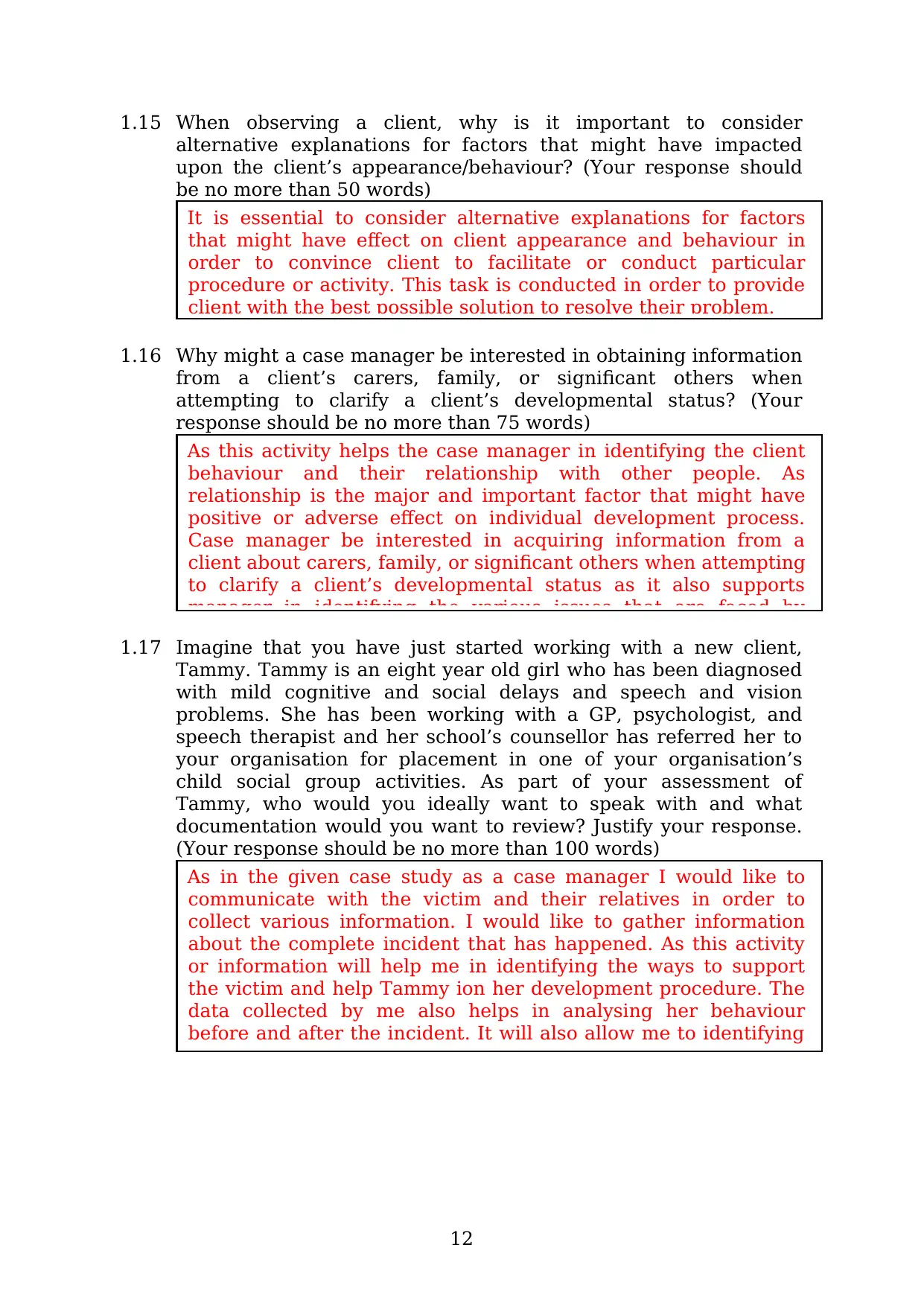
1.15 When observing a client, why is it important to consider
alternative explanations for factors that might have impacted
upon the client’s appearance/behaviour? (Your response should
be no more than 50 words)
1.16 Why might a case manager be interested in obtaining information
from a client’s carers, family, or significant others when
attempting to clarify a client’s developmental status? (Your
response should be no more than 75 words)
1.17 Imagine that you have just started working with a new client,
Tammy. Tammy is an eight year old girl who has been diagnosed
with mild cognitive and social delays and speech and vision
problems. She has been working with a GP, psychologist, and
speech therapist and her school’s counsellor has referred her to
your organisation for placement in one of your organisation’s
child social group activities. As part of your assessment of
Tammy, who would you ideally want to speak with and what
documentation would you want to review? Justify your response.
(Your response should be no more than 100 words)
12
It is essential to consider alternative explanations for factors
that might have effect on client appearance and behaviour in
order to convince client to facilitate or conduct particular
procedure or activity. This task is conducted in order to provide
client with the best possible solution to resolve their problem.
As this activity helps the case manager in identifying the client
behaviour and their relationship with other people. As
relationship is the major and important factor that might have
positive or adverse effect on individual development process.
Case manager be interested in acquiring information from a
client about carers, family, or significant others when attempting
to clarify a client’s developmental status as it also supports
manager in identifying the various issues that are faced by
As in the given case study as a case manager I would like to
communicate with the victim and their relatives in order to
collect various information. I would like to gather information
about the complete incident that has happened. As this activity
or information will help me in identifying the ways to support
the victim and help Tammy ion her development procedure. The
data collected by me also helps in analysing her behaviour
before and after the incident. It will also allow me to identifying
the impact of the incident on her development process and
alternative explanations for factors that might have impacted
upon the client’s appearance/behaviour? (Your response should
be no more than 50 words)
1.16 Why might a case manager be interested in obtaining information
from a client’s carers, family, or significant others when
attempting to clarify a client’s developmental status? (Your
response should be no more than 75 words)
1.17 Imagine that you have just started working with a new client,
Tammy. Tammy is an eight year old girl who has been diagnosed
with mild cognitive and social delays and speech and vision
problems. She has been working with a GP, psychologist, and
speech therapist and her school’s counsellor has referred her to
your organisation for placement in one of your organisation’s
child social group activities. As part of your assessment of
Tammy, who would you ideally want to speak with and what
documentation would you want to review? Justify your response.
(Your response should be no more than 100 words)
12
It is essential to consider alternative explanations for factors
that might have effect on client appearance and behaviour in
order to convince client to facilitate or conduct particular
procedure or activity. This task is conducted in order to provide
client with the best possible solution to resolve their problem.
As this activity helps the case manager in identifying the client
behaviour and their relationship with other people. As
relationship is the major and important factor that might have
positive or adverse effect on individual development process.
Case manager be interested in acquiring information from a
client about carers, family, or significant others when attempting
to clarify a client’s developmental status as it also supports
manager in identifying the various issues that are faced by
As in the given case study as a case manager I would like to
communicate with the victim and their relatives in order to
collect various information. I would like to gather information
about the complete incident that has happened. As this activity
or information will help me in identifying the ways to support
the victim and help Tammy ion her development procedure. The
data collected by me also helps in analysing her behaviour
before and after the incident. It will also allow me to identifying
the impact of the incident on her development process and
⊘ This is a preview!⊘
Do you want full access?
Subscribe today to unlock all pages.

Trusted by 1+ million students worldwide
1 out of 31
Related Documents
Your All-in-One AI-Powered Toolkit for Academic Success.
+13062052269
info@desklib.com
Available 24*7 on WhatsApp / Email
![[object Object]](/_next/static/media/star-bottom.7253800d.svg)
Unlock your academic potential
Copyright © 2020–2025 A2Z Services. All Rights Reserved. Developed and managed by ZUCOL.





